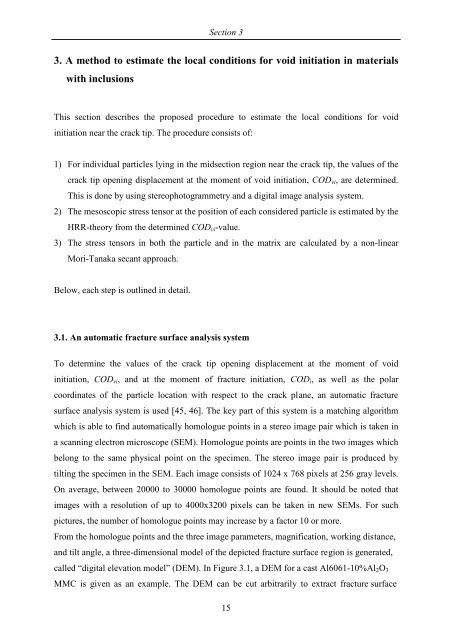dissertation global and local fracture properties of metal matrix ...
dissertation global and local fracture properties of metal matrix ...
dissertation global and local fracture properties of metal matrix ...
Create successful ePaper yourself
Turn your PDF publications into a flip-book with our unique Google optimized e-Paper software.
Section 3<br />
3. A method to estimate the <strong>local</strong> conditions for void initiation in materials<br />
with inclusions<br />
This section describes the proposed procedure to estimate the <strong>local</strong> conditions for void<br />
initiation near the crack tip. The procedure consists <strong>of</strong>:<br />
1) For individual particles lying in the midsection region near the crack tip, the values <strong>of</strong> the<br />
crack tip opening displacement at the moment <strong>of</strong> void initiation, CODvi, are determined.<br />
This is done by using stereophotogrammetry <strong>and</strong> a digital image analysis system.<br />
2) The mesoscopic stress tensor at the position <strong>of</strong> each considered particle is estimated by the<br />
HRR-theory from the determined CODvi-value.<br />
3) The stress tensors in both the particle <strong>and</strong> in the <strong>matrix</strong> are calculated by a non-linear<br />
Mori-Tanaka secant approach.<br />
Below, each step is outlined in detail.<br />
3.1. An automatic <strong>fracture</strong> surface analysis system<br />
To determine the values <strong>of</strong> the crack tip opening displacement at the moment <strong>of</strong> void<br />
initiation, CODvi, <strong>and</strong> at the moment <strong>of</strong> <strong>fracture</strong> initiation, CODi, as well as the polar<br />
coordinates <strong>of</strong> the particle location with respect to the crack plane, an automatic <strong>fracture</strong><br />
surface analysis system is used [45, 46]. The key part <strong>of</strong> this system is a matching algorithm<br />
which is able to find automatically homologue points in a stereo image pair which is taken in<br />
a scanning electron microscope (SEM). Homologue points are points in the two images which<br />
belong to the same physical point on the specimen. The stereo image pair is produced by<br />
tilting the specimen in the SEM. Each image consists <strong>of</strong> 1024 x 768 pixels at 256 gray levels.<br />
On average, between 20000 to 30000 homologue points are found. It should be noted that<br />
images with a resolution <strong>of</strong> up to 4000x3200 pixels can be taken in new SEMs. For such<br />
pictures, the number <strong>of</strong> homologue points may increase by a factor 10 or more.<br />
From the homologue points <strong>and</strong> the three image parameters, magnification, working distance,<br />
<strong>and</strong> tilt angle, a three-dimensional model <strong>of</strong> the depicted <strong>fracture</strong> surface region is generated,<br />
called “digital elevation model” (DEM). In Figure 3.1, a DEM for a cast Al6061-10%Al2O3<br />
MMC is given as an example. The DEM can be cut arbitrarily to extract <strong>fracture</strong> surface<br />
15
















